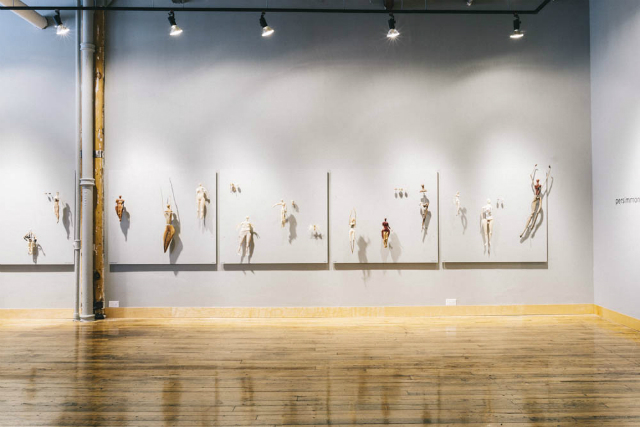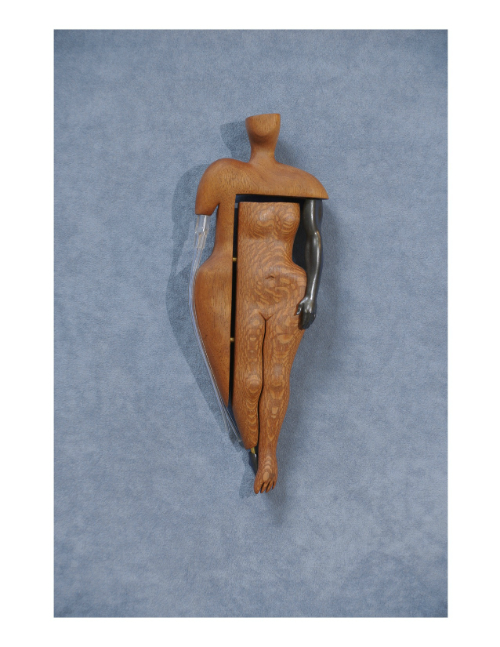
Installation view of Persimmon Blackbridge’s Constructed Identities solo show at Tangled Art Gallery. Credit: Kathy Toth/TAG
Toronto, as a whole, is not a very accessible city. While institutions like the Art Gallery of Ontario have multi-sensory and ASL interpreter tours, there are still stairs everywhere, and it’s not uncommon for smaller galleries or artist-run spaces to apologetically note their washrooms aren’t wheelchair accessible.
Over the past five years, though, there’s been a rise in art that addresses disabilities and madness, not to mention a demand that its paces are truly barrier-free. Last month, Harbourfront Center mounted Cripping the Stage: A Disability Arts Cabaret featuring local disabled artists like jes sachse, Syrus Marcus Ware and Lynx Sainte-Marie.
The event was co-presented by the British Council and Tangled Art + Disability. The local performing arts cum multidisciplinary non-profit supports artists with disabilities, and now has a new exhibition space. And it’s not just any space. They’ve moved into 401 Richmond, a building filled with high profile artist-run centers like A Space, YYZ and Gallery 44. It’s an entrenched arts hub that’s doesn’t just give a gallery space to any organization.
With that new space, change and new programming is now coming forth at a seemingly breakneck speed. Not too long ago, Tangled Arts was known more as a community arts organization, mounting festivals and youth programming in Toronto but also other cities in the province like Ottawa and Thunder Bay. The new gallery space, however, drives home a key aspect of their current mandate: supporting the opportunities of professional artists who are disabled or deaf.
At the center of all this change is the organization’s Artistic Director, Eliza Chandler. Under Chandler’s helm, the organization has launched professional development workshops, and even an artist-in-residence program that provides a shared studio space at 401 and a $5000 stipend. Most importantly, the gallery is putting into action accessible curatorial practices, setting a standard that’s not being met by the majority of galleries in the city.
When I took in the gallery’s inaugural show of new works by Persimmon Blackbridge (best known as a member of the Vancouver lesbian art collective Kiss & Tell) I noticed the curatorial decision to hang the works at the eye level of a seated viewer, such as a person in a wheelchair. The pieces were a series of broken Venus-like figures affixed to large panels throughout the entire gallery, and the use of found materials like bone, metal and doll parts further drove home the allusion to prosthetics. Unsurprisingly, the launch earlier this month was widely covered by local media, coinciding with a widely-attended three-day symposium that opened up a lot of dialogues regarding the relevant issues affecting artists with disabilities.

Detail of work from Blackbridge’s Constructed Identities show at TAG. Credit: Kathy Toth/TAG
As an artist who suffers from a disability herself—Chandler has cerebral palsy—she’s intimately connected to the struggles of artists who also struggle with impairment of one kind or another. And as a practicing artist, she’s had issues in the past making larger sculptural works and needing someone to help her, but was concerned about losing her authorship.
“If I asked for that help, it doesn’t mean my work becomes an artistic collaboration — I still had autonomy,” reasons the NSCAD University alumna. “That was significance for me to my art practice.”
For Chandler, accessible curatorial practices involves “thinking about how to incorporate movement and vibration and accessibility into the work.” At the Blackbridge show, one wall features a touchable sculptural work so it could be tactile to visually impaired visitors, which the gallery specifically commissioned the artist to create for this reason. The show also comes with audio descriptions so visitors could hear the work described. There’s even “relaxed gallery hours” on Wednesday afternoons, where over-stimulating elements (think flashing lights or sound) are toned down for attendees with autism or epilepsy. “The work is presented with different kinds of bodies in mind.”
Founded thirteen years ago as the Abilities Arts Festival, Tangled’s growth coincides with increased funding from the Canada Council for the Arts and Ontario Arts Council (OAC) for artists with disabilities. As a recipient of both, that’s made a tangible difference in Tangled’s programming. As one of the few “Recommender” organizations in OAC’s Exhibition Assistance grant programme, Tangled can distribute grants valued between $500 to $1500 to individual artists covering exhibition-related costs. Artists need that money.
And though Tangled bills its gallery as the first in Ontario to be fully accessible and devoted to the exhibition of disability and deaf art, they’re not alone. In the past ten years, “crip pride” has become a more frequent shorthand for the artist-run organization of festivals and performance projects involving advocacy and activism. Additionally, the disability-related programming of museums and other institutions is increasingly impacting the curatorial decisions of its exhibitions.
Indeed, disability arts has advanced in such a way that organizations like Tangled are adapting as they move forward in serving a previously unrecognized audience. And the wins so far for Chandler—and the rest of us—have been the new and old audiences the Tangled Art Gallery is attracting.
“We have artists who come into the space, and have visited the building for over twenty years, and have never seen the work that we’re presenting,” she says. “And then on the other side, we have artists and audiences who are definitely coming to see the work, and are telling us that this is their first time ever being in a gallery of any kind. Those are wins, you know? It’s great to bring together these worlds.”


Comments on this entry are closed.